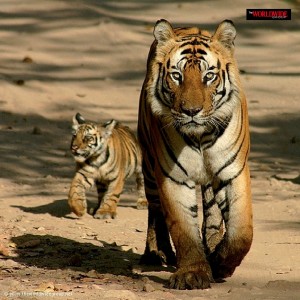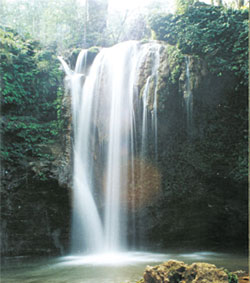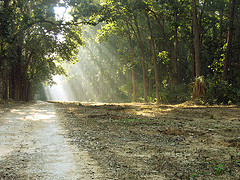Explore the wild jungles and forests of India on India Wildlife Tours. Feel the excitement of seeing a majestic tiger  prowling in a jungle, or elephants and rhinos trampling their way through the tall grass of a National Park in India. See amazing animals on wildlife safari tours in India. Spot wild creatures and explore nature tracts inhabited by rare birds on India Wildlife Tours. Come face to face with a sloth bear or a wild hyena; feel the thrill of photographing a wild lion on the prowl and experience an Indian jungle safari on an India Wildlife Tour. India Wildlife Tours offers unforgettable adventure tours and nature tours to India. Tour India, a land of natural beauty and wonder with exciting India Tours.
prowling in a jungle, or elephants and rhinos trampling their way through the tall grass of a National Park in India. See amazing animals on wildlife safari tours in India. Spot wild creatures and explore nature tracts inhabited by rare birds on India Wildlife Tours. Come face to face with a sloth bear or a wild hyena; feel the thrill of photographing a wild lion on the prowl and experience an Indian jungle safari on an India Wildlife Tour. India Wildlife Tours offers unforgettable adventure tours and nature tours to India. Tour India, a land of natural beauty and wonder with exciting India Tours.
One of the finest habitats of the tiger in India, the Corbett National Park nestles in the foothills of the Himalayas in Uttar Pradesh ( now Uttarachal ) . With its varied topography , diverse flora and fauna and the natural splendor of its landscapes the Park is precious heritage.
Extending over a tract of 520 sq km, the Park is a large valley with forest ridges running through it. The magnificent Ramganga River winds through its entire length in a south-south westerly direction and the numerous forest streams and rivulets that flow into it carve up the area into little ridges and ravines. Dense stands of sal mixed deciduous forests are found throughout the Park while the chaurs or the grasslands in the valley – about one tenths of the core area, offers nature lovers a better view of wildlife.
 The core is bounded to the North by the Kanda Ridge, with a height of 1043 m at its highest point. The entire area of the reserve is mountainous and falls in the Shivalik and Outer Himalaya geological region. It forms the catchment area of the Ramganga, a tributary of the Ganga.
The core is bounded to the North by the Kanda Ridge, with a height of 1043 m at its highest point. The entire area of the reserve is mountainous and falls in the Shivalik and Outer Himalaya geological region. It forms the catchment area of the Ramganga, a tributary of the Ganga.
The Ramganga flows from East to West in the reserve through landscapes of incredible beauty. Dammed at Kalagarh at the south-western end of the reserve in 1974. The reservoir created, submerged 40-sq. km. of prime grassland. The area on the western side of the reservoir now constitutes the Sonanadi Wildlife Sanctuary.
TOURISTS ATTRACTIONS
The main feature of this ridged valley is the Ramganga River, running broadly west by south west, the catchment streams of which vivisect the land into numerous little ridges and ravines. The topography is therefore very varied-the streams forming islands of ‘sheesham’ trees, the ridges being thickly foliated with ‘sal’ trees and the pastures carrying long grasses. In this variety of habitat abounds wildlife of enchanting beauty including 50 mammals, 577 birds and at least 25 reptiles. The river teems with mahseer, gharial, mugger and flocks of cormorants.
Project Tiger was inaugurated here on April 1, 1973. The center of tourist activity in the park always continues to be Dhikala, at the heart of the core area. Here, substantial residential accommodation has been built along one end of a large grassy plateau perched on the edge of the cliff bordering the Ramganga reservoir.
About the Jim Corbett National Park
Jim Corbett National Park, the first wildlife reserve of India, extending over an area of more than 500 sq km in the Himalayan foothills. Corbett national park was established in 1936, as the ‘Hailey National Park’. In 1955-56 it has changed to ‘Ramganga National Park’ and finally Jim Corbett National Park in the honor of legendary hunter-turned- conservationist, best known for hunting man-eating tigers and leopards in the Kumaon and lower Garhwal in the 1920s.
Nearly 73% of the park is covered by dense moist deciduous forest with a predominance of sal trees, accompanied by haldu, pipal, rohini and mango trees. While 10% of the core area is composed of grasslands in the valleys, which offer visitors a better view of Corbett’s wildlife.
Situated in Nainital district of Uttarakhand, the park acts as a protected area for the critically endangered Bengal tiger of India, the secure survival of which is the main objective of Project Tiger, an Indian wildlife protection initiative.
Corbett National Park General Information :
Core Area: 520.82 sq. km,
Buffer Area: 797.72 sq. km,
Total Area: 1318.54 sq. km.
Altitude: 365 m – 1100 m above MSL
Wildlife at It’s Best (Fauna)
Corbett is a haven for Tigers as well as its prey, which include four kinds of Deer, Wild Boar and some lesser-known animals. Leopards are mostly found in the hilly areas of the park. Some nocturnal cats found here are the Leopard Cat, Jungle Cat and Fishing Cat. Sloth Bear is found in the lower regions of the park while the Himalayan Black Bear is seen in the higher hills only. The Dole or Wild Dog, though they can be seen in the southern areas of the park along with the Jackal.
Some of the smaller residents of the park are Himalayan Palm Civet, Indian Gray Mongoose, Common Otter, Blacknaped Hare and Porcupine. Elephants are among one of the main attractions of Jim Corbett Park. Along the Ramganga River shores, one can spot the long-snouted, fish-eating Gharial Crocodile and the ‘Mugger’ Crocodile. Also seen on the rocky hillsides is the Ghoral or Goat Antelopes. The Langur and Rhesus Monkeys are well distributed through out the park and warning the whole Jungle with alarm calls when they see either a Tiger or Leopard from tree-top perches.
The great variety of habitat in Corbett is reflected in its impressive diversity in the bird life. Over 600 species, many of them rare and endangered, have been recorded in and around the park. These include nearly fifty kinds of birds of prey that provide a unique character to the avifauna. Some of the resident and migratory birds categorized, include crested serpent eagles, blossom headed parakeet and the red jungle fowl — ancestor of all domestic fowl. 33 species of reptiles, 7 species of amphibians, 7 species of fish and 37 species of dragonflies have also been recorded.
Main Fauna at (Corbett National Park):
Mammals: Tiger leopard, elephant, chital, sambar, hog deer, barking deer, wild boar, languor, Wild pig, rhesus monkey and jackal.
Birds: Peacock, Jungle Fowl, partridge, Kaleej Pheasant, crow, vulture, parakeet, Laughing Thrush, oriole, kingfisher, drongo, dove, woodpecker, duck, teal, stork, cormorant and seagull;
Reptiles: Indian marsh crocodile, gharial, King cobra, common krait, cobra, Russel viper, python and monitor lizard;
Fish: Mahaseer, kalimuchi, kalabasu, chilwa and goonch.
Nature at It’s Best (Flora)
Corbett’s floral diversity is mind boggling. A total of 488 different species of plants have been recorded in the park.
In association with bhabar about 110 species of trees, 51 species of shrubs, 27 species of climbers and 33 species of bamboo and grass are found. The dominant species of tree is Sal Shorea robusta which is found over 75 % of the total area. In a few areas pure stands of sal are found. Trees like Haldu Adina cardifolia, pipal Ficus religiosa, Rohini Mallotus philipensis and mango Mangifera indica are also commonly found. Sheesham Dalbergia sissoo is found along the Ramganga river.
How to Get there
Air: Phoolbagh, Pantnagar at a distance of 50-kms is the nearest airport. Delhi at a distance of 300-kms is the nearest international airport.
Rail: Ramnagar is on the broad gauge track from where the road transport options have to be availed to reach the park. For faster trains and connections to other parts change at Moradabad.
Road: Dhikala is 300-kms from Delhi, 145-kms from Lucknow and 51-kms from Ramnagar. The route from Delhi spans Hapur-Murababad-Ramnagar. The turn off is some 7-kms beyond Muradabad to the left, marked by a small board. The route from Lucknow spans Bareilly–Kichha–Rudrapur–Doraha–Kashipur. Ramnagar is served by frequent buses to and from Nainital and Ranikhet, 112-kms north. Buses arrive every half hour or so after the eight hour trip from Delhi; Delhi Transport corporation run a semi deluxe service, and most of the alternatives are pretty basic.
Best Time to Visit
Winter (September – March): Days are clear and pleasant, Nights get cold. Great time for bird-watching and Tiger sighting.
Summer (April to June): Hot days with pleasant nights. Ideal time for sighting animals, especially elephants and Tigers.
Monsoon (July – August): Humid days and nights. Great time for walks and trekking. Because of less crowd and rush probability of sighting animals. Good for observing flora.
Corbett remains closed between June 16 and November 14, when the monsoons flood the river beds and cut the fragile road links.
Corbett National Park is mainly divided in three zones for public wildlife sighting
JHIRNA Range remains open round the year.
BIJRANI Range is open from October 1st till June 30th each Year.
DHIKALA Range from November 15th to June 15th each year.
Traveler Tips
– All visitors to Corbett National Park have to obtain permits from the park administration centre at Ramnagar. The closest of the various gates into the Corbett national park, 1-m from central Ramnagar, is on the road to Bijrani camp, 11-km away, a base for day trips. Dhangarhi Gate, 18-kms along the highway north to Ranikhet, provides access to the northern and north western portion of the Jim Corbett Park along the Ramnagar River valley, and to the main camp of Dhikala.
– Visitors are advised to reach the gate half an hour in advance to complete the formalities for entry into the park.
– Elephant safaris are arranged two times a day, starting from Dhikala, at dawn and again in the late afternoon.
– To stay overnight inside Corbett, a permit is required from the park headquarters at Ramnagar. The permit allows visitors to stay for two nights. No permits are issued if the park is too busy.
– Follow the rules, for e.g., do not walk around if you are not permitted to do so
– Wear clothes in shades of brown and green as they are less disturbing to the environment.
– Avoid wearing perfumes and do not smoke in restricted areas.
– Animals are extremely weary of the human voice. Don’t make noise, don’t play music and please don’t honk car horn.
– Don’t leave behind any litter and plastic bags they are big hazards for animals
– Comfortable walking shoes are appropriate than the fashionable ones
Carry Personal medication and insect repellent
Carry Binoculars, Cameras, film rolls and Flashlight along with books and other reading material
Comfortable walking shoes are appropriate than the fashionable ones
For winter travel heavy woolens are a must especially for open jeep safaris. Cottons are apt for summer months
Rain Gear is essential for the monsoons and
Find about the habits of the animal you want to see to avoid disappointment
Lodges & Resorts in Corbett National Park
A number of self contained resorts are springing up on the fringes of Corbett, providing a higher standard of accommodation at a price as well as guides for expeditions in the forests, which can be as rich in wildlife as the Jim Corbett Park, without the restrictions.
Corbett national park offers hotels,resorts and lodges of all categories for the visitors coming to the Park.
Ramganga Resort
Infinity Resort
Tiger Camp Jungle Lodge
Corbett Jungle Retreat
The Wild Crest Resort
Manu Maharani Resort
Corbett Hideaway
Corbett Riverside Resort
Corbett Jungle Club
Corbett River View Retreat
Solluna Resort
Corbett Roop Resort
Camp Forktail Creek Jungle Lodge
Vanghat River Lodge
Camp Riverwild
Country Inn Treetops Resort
Corbett Countyy
Corbett Suman Grand
Corbett Kingdom
Corbett Treff Hotel
Jim’s Jungle Retreat
Corbett Wilds Camp and Retreat
Ashoka’s Tiger Trail
Image Gallery of Jim Corbett National Park
Submit your review | |























Very good,
I want to go on adventures holidays and i think Jim Corbett National Park is the best one ….;)
kya scenes hai!
beautiful post i mean it